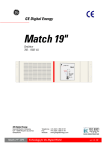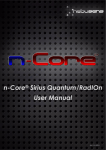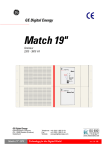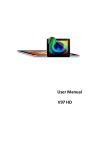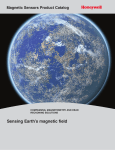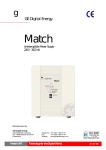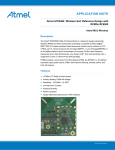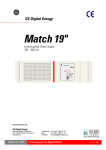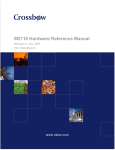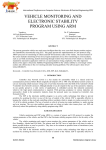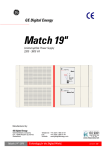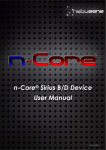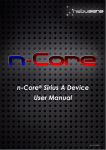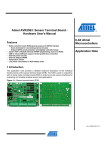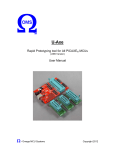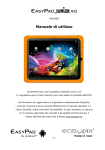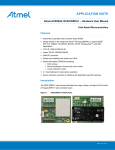Download n-Core® Sirius IOn D-E-M User Manual
Transcript
n-Core® Sirius IOn D-E-M User Manual Rev. 20140326 Sirius IOn D-E-M User Manual Table of contents 1. Introduction ....................................................................................................................... 2 2. General characteristics ................................................................................................... 3 3. Pinout ................................................................................................................................. 4 4. Power supply ..................................................................................................................... 5 4.1. On/Off mode ............................................................................................................................................. 5 4.2. Reset ............................................................................................................................................................ 6 5. Input and output interfaces ............................................................................................. 6 5.1. UART to USB bridge .................................................................................................................................... 7 5.2. ADC ............................................................................................................................................................. 7 5.3. I2C................................................................................................................................................................. 8 5.4. HDMI connector ........................................................................................................................................ 8 5.5. SIC connector ............................................................................................................................................ 9 6. Sensors ............................................................................................................................... 9 6.1. Humidity and Temperature (SHT25) ........................................................................................................ 9 6.2. Light (TSL2561) ............................................................................................................................................ 9 6.3. Light/Proximity (VCNL4000) ...................................................................................................................... 9 6.4. 2D-Axis magnetometer (HMC6352)........................................................................................................ 9 6.5. 3D-Axis accelerometer (MMA8452Q) .................................................................................................... 9 6.6. Reed relay ................................................................................................................................................ 10 7. Recommendations of use and security ....................................................................... 10 8. Additional information ................................................................................................... 11 1 Sirius Ion D-E-M User Manual 1. Introduction The Sirius IOn (models D, E and M) is a flexible expansion board that offers full access to the I/O and programming interfaces of the n-Core Sirius Quantum and RadIOn devices. The Sirius IOn is also compatible with the n-Core Sirius B and D devices. Sirius IOn-D Sirius IOn-E Sirius IOn-M Its adaptable design provides an extraordinary versatility to suit a wide range of applications, especially those where I/O connectivity are key factors. It offers several communication ports and I/O interfaces that allow integrating a great number of external devices, such as sensors, actuators or even computers, among many others. The Sirius IOn device is part of the n-Core platform, developed by Nebusens. The n-Core platform offers a complete set of hardware and software tools that can fit all your necessities when developing and deploying wireless networks based on the IEEE 802.15.4/ZigBee international standard. For more information about n-Core, please visit www.nebusens.com 2 Sirius Ion D-E-M User Manual 2. General characteristics n-Core Sirius IOn (Development) Electrical features External Power Supply 3.7V – 9V Reset Button - Power Switch ON/OFF Physical characteristics Dimensions (mm) 41 x 42 x 15 Connectivity I2C SPI * UART ADC Power Supply SIC / USB / Screw connector * SPI not available via screw connector JTAG HDMI type A / mini JTAG header /JTAG connector I2C SPI UART ADC JTAG GPIO IRQ Device reset Power Supply HDMI type A USB – UART (CP2103) USB via SIC, HDMI or Screw connector Sensors: Reed Relay n-Core Sirius IOn (Environment) Electrical features External Power Supply 3.7V – 9V Reset Button - Power Switch ON/OFF Physical characteristics Dimensions (mm) 41 x 42 x 15 Connectivity SIC / USB / Screw connector Luminosity, Humidity and Temperature via SIC and I2C screw connectors Power Supply Sensors n-Core Sirius IOn (Motion) Electrical features External Power Supply 3.7V – 9V Reset Button - Power Switch ON/OFF Physical characteristics Dimensions (mm) 41 x 42 x 15 Connectivity Power Supply Sensors SIC / USB / Screw connector Accelerometer, Compass and Proximity via SIC and I2C screw connectors 3 Sirius Ion D-E-M User Manual 3. Pinout UART HDMI TXD RXD ADC IN 1 … 19 ADC GND 2 1 SIC 10 9 2 ON 1 JTAG 10 9 OFF VCC GND SCL SDA USB VCC IN 1 2 3 4 5 6 7 8 9 10 11 12 13 14 15 16 17 18 19 HDMI JTAG TDI UART TXD JTAG TDO SPI MISO JTAG TMS SPI MOSI JTAG TCK SPI CLK ADC 1 UART RTS VCC OUT UART CTS GND UART RXD I2C SCL Reed Relay OUT Not Used I2C SDA RESET (Sirius Quantum and RadIOn) 1 2 3 4 5 6 7 8 9 10 I 2C SIC I2C SCL SPI SCK I2C SDA SPI MOSI VCC OUT SPI MISO UART RXD UART TXD ADC (wired to ADC block) GND 4 1 2 3 4 5 6 7 8 9 10 JTAG TCK GND TDO 3.3 V output (permanent) TMS RESET N/C N/C TDI GND Sirius Ion D-E-M User Manual 4. Power supply UART Sirius IOn device has two alternatives for power supply: 2-pole connector (VCC_IN): 5 – 9V DC (Sirius Quantum or Sirius RadIOn connected via the HDMI). 3.7V – 9V DC (Sirius RadIOn connected via SIC). 5V – 9V DC (Sirius B or Sirius D connected via SIC). Type-B Mini USB connector: 5V DC. HDMI TXD RXD ADC IN 1 … 19 ADC GND 2 10 SIC 1 9 2 ON 10 JTAG 1 9 OFF Important note: Use only the following combinations when powering the Sirius Quantum and RadIOn devices: VCC GND SCL SDA USB Via the HDMI connector: VCC_IN or USB can be used. The USB charges the internal VCC IN I 2C battery of the Sirius Quantum (or an external battery directly connected to the Sirius RadIOn). Via the SIC connector: VCC_IN or USB can be used ONLY if there is not a battery or external power supply directly connected to the Sirius device. Important note: be sure to respect the power polarity or the device may be damaged permanently. UART 4.1. On/Off mode The On/Off button is placed on left side of the device. This switch allows eliminating completely the power supply of the Sirius IOn device and also the power supply of the Sirius B, D, Quantum RadIOn and devices attached to it. HDMI TXD RXD ADC IN 1 … 19 ADC GND 2 1. Device switched on. 2. Device switched off. 1 SIC 10 9 2 ON 1 OFF 2 1 VCC GND SCL JTAG 10 9 SDA USB VCC IN 5 I 2C Sirius Ion D-E-M User Manual 4.2. Reset The Reset button is placed at the opposite layer of the USB connector. This button allows resetting the Sirius Quantum or RadIOn devices when they are attached via the HDMI connector. UART HDMI TXD RXD ADC IN 1 … 19 ADC GND 2 1 SIC 10 9 2 ON 1 JTAG 10 9 OFF VCC GND SCL SDA USB VCC IN I 2C 5. Input and output interfaces The Sirius IOn device has the following input and output interfaces: UART/USB (UART, SIC and HDMI connectors). Allows accessing the Sirius B, D, Quantum and RadIOn UART. ADC (SIC and HDMI connectors). I2C (SIC and HDMI connectors). HDMI connector. It allows: Accessing the Sirius Quantum and RadIOn input and output interfaces: ADC, I2C, SPI, GPIO, UART and JTAG. Powering the Sirius B, D, Quantum and RadIOn devices. Updating the firmware on the Sirius Quantum and RadIOn devices. SIC. It allows: Accessing the Sirius B, D, Quantum and RadIOn input and output interfaces: ADC, I2C and UART. Powering the Sirius B, D, Quantum and RadIOn devices. 6 Sirius Ion D-E-M User Manual 5.1. UART to USB bridge This interface uses the Silabs CP2103 and is recognized by the operating system (e.g., Windows) as a virtual serial port (Virtual Com Port). UART HDMI TXD RXD ADC IN 1 … 19 ADC GND The UART of the Sirius devices can be accessed via the SIC, HDMI and UART connectors. 2 1 SIC 10 9 It allows: 2 ON Communicating with the Sirius B, D, Quantum and RadIOn via their UART. Sirius B and D: USART0 (0x1E, 0x1F) of the ATmega1281V. Sirius Quantum and RadIOn: USART1 (0x13, 0x14) of ATmega128RFA1. Powering the Sirius B, D, Quantum and RadIOn devices. 1 JTAG 10 9 OFF VCC GND SCL SDA USB VCC IN I 2C Note: the UART side of the CP2103 can be also accessed by using the UART connector (green). UART 5.2. ADC HDMI The ADC can be accessed via: ADC connector. SIC connector. HDMI connector. TXD RXD ADC IN 1 … 19 ADC GND It allows: 2 1 Accessing the ADC_1 (0x01) of the ATmega1281 on Sirius B and D. Accessing the ADC_1 (0x01) of the ATmega128RFA1 on Sirius Quantum and RadIOn. The input voltage must be between 0V and 1.5V. SIC 10 9 2 ON 1 JTAG 10 9 OFF VCC GND SCL SDA USB VCC IN 7 I 2C Sirius Ion D-E-M User Manual 5.3. I2C UART HDMI The I2C can be accessed via: TXD RXD ADC IN I2C connector. SIC connector. HDMI connector. … 19 ADC GND It allows: 2 1 Accessing to the I2C of the ATmega1281 on Sirius B and D Accessing to the I2C of the ATmega128RFA1 on Sirius Quantum and RadIOn. I2C is also connected to several depending on the Sirius IOn model: 1 SIC 9 2 ON 1 JTAG 10 9 OFF sensors1 VCC GND SCL SDA USB Sirius IOn-E Humidity/Temperature (SHT25). Light (TSL2561). Sirius IOn-M 2D-Axis magnetometer (HMC6352). 3D-Axis accelerometer (MMA8452Q). Light/Proximity (VCNL4000). VCC IN I 2C UART 5.4. HDMI connector HDMI This is a multipurpose connector. It allows: Accessing the Sirius Quantum and RadIOn internal interfaces: I2C, ADC, UART, IRQ and JTAG. Resetting the Sirius Quantum and RadIOn devices. Recharging the Sirius Quantum integrated battery (or an external battery connected to the Sirius RadIOn). 10 TXD RXD ADC IN 1 … 19 ADC GND 2 1 SIC 10 9 2 ON 1 JTAG 10 9 OFF Note: It is necessary to use a HDMI male to micro HDMI male cable or adapter. VCC GND SCL SDA USB VCC IN 1 Please read AppNote n-Core ConfTool Sensors for more information. 8 I 2C Sirius Ion D-E-M User Manual 5.5. SIC connector It is a multipurpose connector. It allows: Accessing the Sirius B, D, Quantum and RadIOn internal interfaces: I2C, ADC and UART. 6. Sensors 6.1. Humidity and Temperature (SHT25) Precision relative humidity and temperature I2C sensor with auto-calibration. Can be acceded using: I2C connector. SIC connector. HDMI connector. 6.2. Light (TSL2561) Ambient light I2C sensor. Can be acceded using: I2C connector. SIC connector. HDMI connector. 6.3. Light/Proximity (VCNL4000) Ambient light and infrared proximity I2C sensor. Can be acceded using: I2C connector. SIC connector. HDMI connector. 6.4. 2D-Axis magnetometer (HMC6352) 2D-Axis I2C magnetometer and digital compass. Can be acceded using: I2C connector. SIC connector. HDMI connector. 6.5. 3D-Axis accelerometer (MMA8452Q) 3D-Axis I2C accelerometer. Can be acceded using: I2C connector. SIC connector. 9 Sirius Ion D-E-M User Manual HDMI connector. 6.6. Reed relay Digital On/Off magnetic sensor (0x22 in Sirius B/D). Internal pull-up must be activated. 7. Recommendations of use and security Please, follow the next indications in order to obtain the maximum performance and to use the Sirius IOn device in a safe way: Avoid placing metallic objects near the device as far as possible. Architectonic elements, such as metallic walls, doors, railings, pipes, concrete walls, among many others, can affect signal quality and, therefore, the maximum distance of communication between devices. Do not wet the device. Do not store or make use of the device in atmospheres with a high humidity rate (70% as maximum). Do not expose the device to heat sources or directly to the sun. Avoid short-circuiting connections. Do not use cables longer than 3 meters. Pay special attention to relay output connections, because it could cause a short circuit in the device to be controlled. Do not apply to the device voltages and currents out of maximum and minimum rates recommended in this manual (both in power supply and input/output ports, as well as communication buses). Use an appropriate external power supply. The product must only work with the type of power supply indicated in this manual. If you are not sure about the type of the required power supply, please consult the manufacturer. Avoid manipulating any element of the device not described in this manual, because the warranty could be invalidated and the equipment could be damaged permanently. Do not use this product in gas stations, fuel tanks, chemical plants or places where demolition operations are being carried out or near potentially explosive atmospheres, such as re-fuelling areas, fuel tanks, under boat decks, chemical plants, facilities of transference or storage of fuel or chemical agents and areas where the air contains chemistries or particles, such as grain, metallic dust or dust. Please, consult the pertinent preventive measures before using this device in these kinds of zones. The use of accessories unapproved by the manufacturer could damage the equipment, break local laws and invalidate the warranty. Use only the antenna that is delivered with the device. The use of modified or unauthorized antennas can reduce the quality of the communication and damage the equipment, besides break local regulations of your country. 10 Sirius Ion D-E-M User Manual 8. Additional information Disclaimer Nebusens believes that all information is correct and accurate at the time of issue. Nebusens reserves the right to make changes to this product without prior notice. Please visit the Nebusens website (www.nebusens.com) for the latest available version. Nebusens does not assume any responsibility for the use of the described product or convey any license under its patent rights. Nebusens warrants performance of its products to the specifications applicable at the time of sale in accordance with the sale and use conditions of n-Core. You can check these conditions on the Nebusens website (www.nebusens.com). Trademarks n-Core and related naming and logos are trademarks of Nebusens, S.L. All other product names, trade names, trademarks, logos or service names are the property of their respective owners. Technical Support Technical support is provided by Nebusens, S.L. on demand and in accordance to sale and use conditions agreed. You can check these conditions on the Nebusens website (www.nebusens.com). We provide you with a support forum (support.nebusens.com) for any question related to the n-Core platform. Waste and recycling When the device reaches the end of its life cycle, it will have to be deposited in a point of recycling for electronic equipment. The equipment will not have to be deposited in the points of urban garbage collection. Please, go to a specialized point. Your distributor will indicate the most appropriate way to proceed with the recycle of the device. 11















